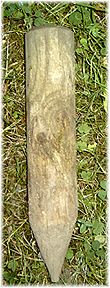Peg
A peg is a mostly cylindrical piece of wood, often pointed at one end . Larger objects are called stakes . With the pointed end of the peg can be pushed so far into the ground that it takes firm hold and as a stayer so detached, as a post or support as a stand can be used. In Appenzell Innerrhoden ( Switzerland ) also known as Schöttler in the broader sense .
material
Modern pegs can be made of metal, concrete or plastics. Nevertheless, wood is still in use in many areas as a cheap and robust material, provided it is adequately protected from weathering.
Historically, pegs were made of solid round wood , from short sections of small wood to long wood (whole logs).
Possible uses
Sometimes special terms are used for “peg”.
- Fence post, shaped so that its upper end can be used to attach wire or lath fences .
- Poles for fastening ships to moorings.
- Bollards are various transversely stable components similar to the dolphin or similar to the fence as a barrier or collision protection in road traffic.
- Herring are particularly sturdy pegs for larger tents.
- Wooden nails are used in carpentry to secure wood connections through wood.
- Belay nails are used in shipping for easily variable fastening of cordage.
- Masts are made of wood up to the size of a tree (for telephone lines or in the medium-voltage network of the energy supply or as a ship's mast ). However, technical trusses are necessary for larger lines.
- Driven pile : as a pile foundation for buildings. Wooden foundations are the simplest construction technique for poorly stable subsoil. In modern technology, they are often replaced by iron or concrete piles in order to also carry skyscrapers or oil rigs . The stake in hydraulic engineering is called a pilot , these are the posts on which jetties or buildings on the water ( stilts ) stand. Historically since the Neolithic, pile construction has been carried out on or in the water or as a boathouse to this day .
- Palisades are historical fortifications that were built around settlements or as an obstacle to overcome with piles placed close together.
- in hydraulic engineering for the production of battles .
In addition, pegs and stakes are used in a variety of ways in everyday life, for example in horticulture as a beanpole or tomato trellis.
The “ torture stake ” is known from the so-called Wild West Romanticism, which is actually a totem pole . These are common in a number of cultures and serve the cult of ancestors rather than binding enemies.
In fantasy novels and horror stories, a stake is often used to kill a vampire for good. The stake must be driven through his heart. While in older vampire stories the nocturnal vampire had to be haunted asleep in his coffin in his dungeon during the day, in more modern stories the victory over the undead often only comes after a spectacular duel.
additional
In the symbolism, the stake represents the world axis , i.e. the connection between heaven and earth.
Individual evidence
- ↑ Udo Becker: Lexicon of symbols . Nikol Verlag (licensed by Herder Verlag ), Hamburg 2012, ISBN 978-3-86820-139-0 , p. 216 .
